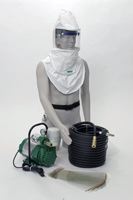 |
 |
| MSDS Topics |
Free Sites | FAQ's | Regulations | Glossary | Software | Suppliers |
| Books | Forum | Poll | Fun stuff | Quiz | Store | |
| MSDS and safety supplies | Search ALL our MSDS info | |||||
 | |||
 |
 |
 |
|
| Title: 04/03/1990 - Hazard Communication Standard. | |
| Record Type: Interpretation | Standard Number: 1910.1200 |
April 3, 1990
Michael G. Michaelson, M.D.
Covington & Burling
1201 Pennsylvania Avenue, N.W.
Washington, D.C. 20044
Thank you for your letter of February 23, to the Occupational Safety and Health Administration (OSHA) regarding the application of the Hazard Communication Standard (HCS), 29 CFR 1910.1200, to your client's product, calcium silicate pre-molded insulation materials.
You were specifically interested in whether the labeling requirements of the HCS would apply to your client's product which, under normal conditions of use, (i.e., cutting operations conducted during fabrication applications of the product) emits crystalline silica. The specific determination regarding coverage for a product is to be made by the chemical manufacturer or importer, which in this case is your client. If the crystalline silica is available for exposure, the rule applies. According to the test data you presented, crystalline silica was detected in the samples your client took which simulated the types of exposures that would occur under normal conditions of use. In your letter, you described sampling operations conducted by your client at three of four worksites where, in one case, "crystalline silica appeared to be present at levels greater than 0.1%" of the dust sampled. The crystalline silica emitted is, therefore, "available for exposure." Your client believes that exposure to dust containing more than 0.1% crystalline silica would occur "fewer than 10%" of the time in normal downstream uses of his product.
Because of this information, you requested that your client be allowed to warn of the carcinogenic hazard due to the presence of crystalline silica in his product only on the MSDS but not on the label. It is the Agency's policy that hazard warnings must appear on the MSDS and the label of a chemical product when a carcinogenic substance is present in amounts greater than 0.1%. Exposure calculations are not permitted in determining whether a hazard must appear on a label in that if there is a potential for exposure (other than in minute trace, or very small quantities), the hazard must be included. Additionally, suppliers may not exclude hazards based on presumed levels of exposure downstream (i.e., omitting a carcinogenic hazard warning because, in their estimate, presumed exposures will not be high enough to cause the effect).
|
In the situation you described in your letter, a warning may not be excluded from the label just because exposure to the hazardous substance may only occur in 10% of downstream operations. As you are aware, and as stated in your letter, "the purpose of the HCS is communication." Employees have a right to know about the presence of hazardous substances in the materials they are required to work with. The purpose of the label is to serve as an immediate hazard warning of the health or physical hazard(s) that employees may be exposed to while working with the chemical. With this information, employees can take the proper precautionary measures necessary to protect themselves from exposure. Labels also provide a link to the more detailed information available on the MSDS. However, just because a hazard is detailed on the MSDS does not mean that information does not have to appear as a warning on the label. I hope this helps clarify the concerns raised by your client regarding this issue. Please feel free to contact us again if we can be of further assistance. Sincerely, |  Protect yourself during sandblasting with a complete supplied air respirator system like this one from Safety Emporium. |
Gerard F. Scannell
Assistant Secretary
The official, public domain, OSHA version of this document is available at http://www.osha.gov/pls/oshaweb/owadisp.show_document?p_table=INTERPRETATIONS&p_id=19956&p_text_version=FALSE